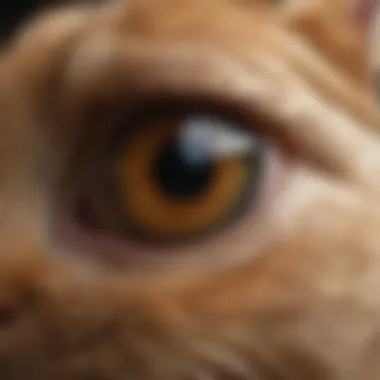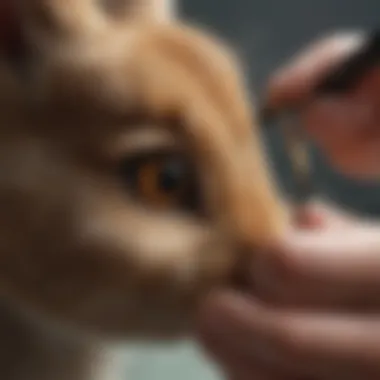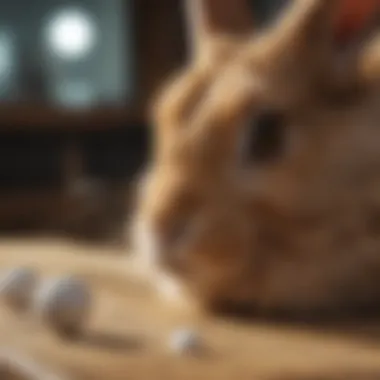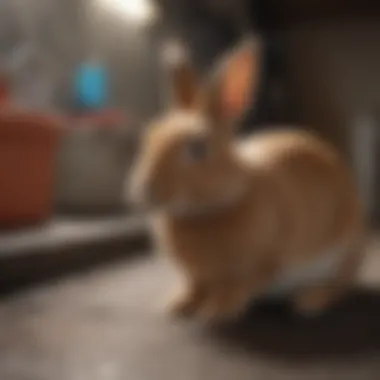Effective Treatment Strategies for Rabbit Eye Infections


Intro
Eye infections in rabbits are a pressing issue that every owner should take seriously. These infections, if left untreated, can lead to serious health complications. Understanding the various elements involved in rabbit eye health can empower pet owners to detect and treat problems quickly. This guide aims to delve into the complexities surrounding eye infections in rabbits, providing details from causes and symptoms to diagnosis, prevention, and treatment options. A key focus will be on aftercare and knowing when to consult a veterinary professional.
Understanding Your Pet
To effectively manage eye infections in rabbits, it is essential to have a good grasp of their behavior and needs. Each breed has specific characteristics that can impact their health and predisposition to certain conditions.
Pet Behavior Basics
Rabbits are generally social and active animals. Understanding their typical behavior can help owners identify when something is wrong. For instance, a rabbit that is less active than usual may be showing signs of distress or illness, which includes potential eye problems.
Common Breed Characteristics
Different rabbit breeds may have varying susceptibility to eye infections. For example, breeds with prominent eyes may be at a higher risk due to their anatomy. Breeds like the Holland Lop and the Lionhead are known for their eye structure, making them more prone to conditions such as conjunctivitis. Knowing these traits can be useful for proactive care.
Species-Specific Needs
Rabbits need appropriate environments and nutrition to support overall well-being. A clean habitat and a balanced diet can minimize the risk of many health issues, including eye infections. Ensure that your rabbit's living area is free from dust and other irritants which could potentially harm their delicate eyes.
Health and Wellness
Routine health check-ups and awareness of vaccination needs are critical to maintaining a rabbit's health. Eye infections can often indicate underlying health issues that might need addressing.
Routine Vet Check-ups
Regular visits to the veterinarian allow for early detection of health problems, including eye infections. A vet can assess your rabbit’s eyes for any signs of infection and recommend an appropriate treatment plan tailored to your pet’s needs.
Vaccination Needs
Vaccinating rabbits helps prevent diseases that might compromise their immune systems, making them more susceptible to infections, including those affecting the eyes. Follow your veterinarian's advice on vaccination schedules to keep your rabbit protected.
Recognizing Signs of Illness
Being observant is crucial. Look for symptoms like discharge, redness, or swelling around the eyes. These could be early indicators of an infection. If you notice any of these signs, it is imperative to consult a veterinarian promptly to avoid complications.
Pet Care and Maintenance
Proper care and maintenance are essential to prevent eye infections. This includes the right feeding habits, grooming routines, and hygiene practices.
Feeding Guidelines
A rabbit’s diet should be primarily based on hay, fresh vegetables, and a limited amount of pellets. A proper diet can contribute to overall health and reduce the risk of infections. Avoid sugary treats that can lead to obesity and health issues.
Grooming Essentials
Regular grooming helps maintain clean fur and can prevent irritation that might lead to eye problems. Pay attention to the areas around the eyes when grooming; make sure they are clean and free from debris.
Hygiene Practices
Keeping your rabbit's living area clean is vital. Remove waste daily and provide fresh bedding. This practice reduces the likelihood of bacteria that can lead to infections.
Enrichment and Activities
Engaging your rabbit in activities not only stimulates their mind but also contributes to their overall health. This can include searching for treats or playing with safe toys.
Indoor vs.
Outdoor Activities
Balancing indoor and outdoor activities is important for physical and mental stimulation. Ensure that outdoor spaces are free from potential hazards. An enclosed area can provide a safe environment for exploration.
Interactive Toys and Games


Using interactive toys can keep a rabbit busy and mentally stimulated, which is essential for their overall health. Consider toys that encourage foraging, as they promote natural behaviors that are beneficial.
Socialization Opportunities
Rabbits are social creatures, and interacting with other pets or humans can be beneficial. Proper socialization can reduce stress and anxiety, which indirectly affects their health.
Continuous education and awareness are crucial for maintaining your rabbit's health. Eye infections, while treatable, require quick and informed actions from pet owners.
Through understanding, proactive care, and routine maintenance, rabbit owners can significantly reduce the risk of eye infections and ensure their pets lead happy, healthy lives.
Prelims to Rabbit Eye Infections
Eye infections in rabbits are not just a minor issue; they can lead to serious complications if not properly addressed. Thus, understanding this topic gives pet owners critical insights into maintaining their rabbit's overall health. This section serves as an introductory framework for a comprehensive exploration of rabbit eye infections, highlighting the significance of timely diagnosis and intervention.
Understanding the Anatomy of Rabbit Eyes
Rabbits have unique and complex eye structures. Their eyes are positioned on the sides of their heads, which provides an extensive field of vision. This wide-angle vision helps them detect predators quickly. However, it also means that they are prone to certain types of injuries and infections that may affect their delicate ocular system. The main components of a rabbit's eye include the cornea, lens, iris, and retina. Each part plays a vital role in vision and overall eye health. A healthy eye has clear, moist surfaces and free of any obstructions or infections.
Understanding the anatomy is crucial for identifying potential issues. For instance, the cornea is a barrier against dirt and pathogens. If damaged, it can lead to infections resulting from exposure. Knowledge of eye anatomy helps in recognizing symptoms early and seeking appropriate care.
Common Causes of Eye Infections in Rabbits
Eye infections in rabbits can arise from various sources. Here are some common culprits:
- Bacterial Infections: Bacteria can enter through injuries or compromised immune systems.
- Viral Infections: Some viruses, like myxomatosis, can cause severe eye issues in rabbits.
- Parasitic Infestations: External parasites like mites can irritate the eyes.
- Environmental Factors: Dust, allergens, and poor housing conditions can lead to infections.
- Trauma: Scratches or injuries can precipitate infections.
It’s essential for rabbit owners to observe their pets’ environments and health, as these factors can significantly impact eye health. Being informed helps in preventative care and in recognizing red flags that necessitate further investigation.
Understanding these causes equips rabbit owners with the knowledge needed to maintain their pets' eye health. Regular check-ups and attention to environmental conditions are key to preventing infections.
Recognizing Symptoms of Eye Infections
Recognizing the symptoms of eye infections in rabbits is crucial for early intervention and treatment. Timely recognition helps mitigate serious complications that can arise from untreated infections. Numerous factors can influence the symptoms exhibited by infected rabbits. Pet owners need to be observant and knowledgeable about these signs to provide the necessary care.
Visible Signs of Infection
Visible signs of eye infections can manifest in various ways. Often, the first indicators include:
- Redness or Swelling: Affected eyes may appear red or swollen. This can be one of the most evident signs of infection.
- Discharge: Abnormal discharge, whether watery or pus-like, is another strong symptom. The consistency and color can vary based on the type of infection.
- Cloudiness: Cloudy eyes may indicate inflammation or infections that require immediate attention.
- Squinting or Excessive Blinking: Rabbits may squint as a response to discomfort in the infected eye.
- Rubbing the Eye: If a rabbit frequently rubs or paw at its eye, it may indicate irritation or pain.
As a pet owner, monitoring these signs can help facilitate prompt veterinary care. Ignoring such symptoms can lead to more severe health issues.
Behavioral Changes in Infected Rabbits
Behavioral changes can provide insight into the general well-being of rabbits. Eye infections may produce notable alterations in behavior, including:
- Decreased Activity: Infected rabbits may become lethargic and avoid their usual activities.
- Appetite Changes: A sudden loss of appetite can indicate that the rabbit is in discomfort or pain.
- Hiding: Many rabbits instinctively hide when feeling unwell. An isolated rabbit may warrant further examination.
- Aggressiveness or Withdrawn Nature: An infected rabbit can become irritable or withdrawn, reflecting its discomfort.
- Inability to Clean Itself: Eye discomfort may hinder a rabbit's ability to groom itself, leading to unkempt fur and noticeable changes in hygiene.
Timely observation and action are vital for ensuring the health and well-being of your rabbit. Catching symptoms early can mean the difference between a simple treatment and a serious health crisis.
Understanding these visible signs and behavioral changes is essential for safeguarding your rabbit’s health. By being cognizant of such symptoms, you can enhance your rabbit's quality of life and ensure prompt medical attention when necessary.
Diagnosis of Rabbit Eye Infections
Diagnosing eye infections in rabbits is a critical step in managing their health. Early and accurate diagnosis can prevent complications that lead to serious health issues for these pets. Owners should understand the key components involved in the diagnosis process and the importance of seeking veterinary help.
Veterinary Examination Procedures
The first step in diagnosing an eye infection is a thorough veterinary examination. During this procedure, the veterinarian will assess the rabbit's overall health and specifically examine the eyes. This involves:
- Observation: The vet will look for visible signs of infection, such as redness, swelling, or discharge. They may observe the rabbit's behavior for clues of discomfort and sensitivity.
- Physical Examination: A comprehensive physical exam will be conducted to rule out other health concerns. The vet often checks vital signs and general well-being.
- Eye Examination: Specialized tools, like an ophthalmoscope, are used to closely inspect the internal structures of the eye. This helps determine if the infection has affected deeper tissues.
Keeping an eye on your rabbit during these exams can provide valuable insights to the veterinarian. Being mindful of behavior and any sudden changes can aid in accurate diagnosis.
Diagnostic Tests and Their Relevance


In some cases, further diagnostic tests may be necessary to establish the cause and extent of the eye infection. These tests can include:
- Fluorescein Staining: This test checks for corneal injuries or ulcers. A dye is applied to the eye, and any damaged areas will absorb the dye, revealing issues.
- Culture and Sensitivity Testing: If the infection is severe or persistent, a sample of the discharge may be taken. This allows for the identification of specific bacteria or pathogens and helps guide antibiotic treatment.
- Blood Tests: Sometimes, blood tests may be recommended to determine if the infection is part of a broader systemic issue.
Understanding these tests is pivotal for owners. They shed light on the health status of the rabbit and aid in determining the most effective treatment plan.
Timely diagnosis supports better treatment outcomes. Pet owners who notice symptoms of ocular distress should not hesitate to consult their veterinarian. Early intervention can be life-saving, ensuring that the rabbit maintains a good quality of life.
Treatment Options for Eye Infections
Treating eye infections in rabbits is crucial for their overall health and quality of life. Ignoring such conditions can lead to complications, including permanent vision loss or chronic pain. Understanding the various treatment options available is essential for rabbit owners. The primary aim is to alleviate the infection and prevent recurrence. The right treatment also depends on the severity and cause of the infection, and being informed can lead to better care choices for your pet.
Topical Medications and Eye Drops
Topical medications are often the first line of defense against eye infections in rabbits. These can include medicated eye drops or ointments that help reduce inflammation and kill bacteria. Common ingredients found in these products might include antibiotics or anti-inflammatory agents.
Application of these medications needs to be done carefully. Here are a few considerations:
- Clean the eye area gently before application to avoid introducing more bacteria.
- Follow prescribed dosages strictly. Overmedicating can cause further irritation.
- Observe your rabbit for any adverse reactions after administration.
In many cases, topical treatments can effectively resolve the problem without proceeding to more invasive methods. For mild infections, they can bring about quick improvement and reduce discomfort.
Oral Medications and Antibiotics
In instances where the infection is more severe or has spread beyond the eye, oral medications become necessary. Antibiotics can be prescribed based on the specific bacteria identified through diagnostic tests. Ensure you discuss with your veterinarian about:
- The necessity of finishing the entire course, even if symptoms improve.
- Possible side effects, such as gastrointestinal upset or allergic reactions.
- Interactions with other medications your rabbit might be taking.
Oral medications are effective in treating systemic infections and can provide relief for underlying issues, enhancing overall health for your pet. Additionally, monitoring your rabbit during this time will help you catch any complications early.
Surgical Interventions for Severe Cases
In severe cases, surgical intervention may be required. This is usually reserved for instances where other treatments have failed or the eye condition has progressed significantly. Surgery might include:
- Draining abscesses that form due to infection.
- Removing severely affected tissues or even the eye, if deemed necessary.
The decision to pursue surgical options involves careful consideration. Discuss with your veterinarian all potential risks and benefits, along with the anticipated recovery period. Post-surgery care will also be vital to ensure proper healing.
Overall, treating eye infections in rabbits necessitates a combination of immediate care and long-term planning.
Preventive Measures for Eye Health
Maintaining the eye health of rabbits is essential for their overall well-being. Preventive measures can significantly reduce the risk of eye infections, which, if ignored, can lead to severe complications. It is important for pet owners to be proactive in understanding and implementing these measures. With proper care, the chances of an infection occurring can be minimized.
Environmental Factors to Consider
The environment where a rabbit lives plays a crucial role in eye health. Here are some key factors to consider:
- Cleanliness: Keeping the rabbit's living space clean is vital. Regularly remove soiled bedding and waste to prevent bacteria buildup. A clean environment helps in warding off infections.
- Ventilation: Good airflow can reduce humidity levels, which can help prevent the growth of pathogens. Avoid areas with excess dust or smoke, as these can irritate a rabbit's eyes.
- Safety from Hazards: Ensure there are no sharp objects or chemicals in the rabbit's environment that might cause injuries to the eyes. Be cautious with items like cleaning supplies or small movable parts that rabbits might chew on.
By paying attention to these environmental factors, rabbit owners can create a safer and healthier habitat for their pets.
Regular Health Check-Ups
Routine health check-ups are an essential part of rabbit care. They serve as a preventive measure against potential health issues, including eye infections. Here are the advantages of regular veterinary visits:
- Early Detection: Routine examinations can help in identifying any early signs of eye problems. Observing subtle changes in a rabbit’s eyes can lead to earlier treatment if necessary.
- Vaccination Status: Staying current with vaccinations is vital. Certain diseases can lead to complications affecting the eyes. Consulting a veterinarian regularly ensures that all vaccinations are up to date.
- Professional Cleaning: Some veterinarians offer professional cleaning of a rabbit's eyes and surrounding areas. This can be particularly helpful for breeds with long fur that might obstruct vision and trap debris.
In summary, integrating preventive measures into the care regimen of rabbits is critical. These steps not only protect the eyes but also contribute to the overall health and happiness of these pets. Owners should remember that preventive care is often more effective than treating an existing condition.
Home Care During Recovery
Home care plays a crucial role in the recovery of rabbits from eye infections. A comforting and well-managed environment can significantly influence the healing process. When rabbits do not feel stress, they often respond better to treatment. Ensuring that pet owners understand the relevance of home care is vital for the successful recovery of their furry companions.


Creating a Comfortable Environment
A peaceful environment is essential for rabbits recuperating from eye infections. Pet owners should assess and adjust their home setups to minimize anxiety. Here are several tips to create a suitable space for recovery:
- Quiet Area: Choose a space away from loud noises and distractions, as stress can slow healing.
- Appropriate Bedding: Use soft, clean bedding to give comfort. Avoid materials that might irritate their eyes.
- Temperature Control: Maintain a comfortable temperature in the recovery area. Rabbits can be sensitive to extremes in heat and cold.
- Safe Access: Ensure that the rabbit can move around safely without obstacles that could lead to further injury or stress.
The benefits of creating a comfortable environment include reduced stress levels, which can facilitate quicker healing. Without distractions or disturbances, rabbits can focus their energy on recuperating.
Administering Medications at Home
Proper medication administration is important for recovery and requires attention from the pet owner. Understanding the treatment plan given by the veterinarian is essential. Medications might include topical drops or oral antibiotics.
- Read Instructions: Carefully read and follow the vet's instructions regarding dosage and timing to avoid complications.
- Calm Restraint: While administering medications, handle the rabbit gently but firmly. A calm approach will make it easier for the rabbit to accept treatment.
- Pill Administering Techniques: For oral medications, using a small syringe can aid in administering liquid meds. Ensure that the rabbit swallows the medication by gently holding its mouth closed for a moment.
- Monitor Reactions: After giving medication, closely observe the rabbit for any negative reactions. Report unusual behaviors or side effects to the vet promptly.
Proper care and attention to medication can be the difference between a smooth recovery and serious complications.
In summary, home care during the recovery of rabbits is crucial for mitigating anxiety and ensuring medication compliance. By creating a stable environment and carefully following medication guidelines, pet owners can support their rabbits in healing effectively.
Long-term Care Considerations
Long-term care of rabbit eye health is crucial for preventing future infections and ensuring the overall well-being of your pet. Rabbits can be prone to various eye conditions, and ongoing attention can help mitigate these risks. This care involves monitoring, nutrition, and environmental assessments. Pet owners must understand these elements to maintain their rabbit's health effectively.
Regular Monitoring of Eye Health
Regular monitoring is an essential aspect of long-term care. It allows pet owners to quickly detect any changes in their rabbit's eye condition. Here are some key points:
- Routine Observations: Make it a habit to check your rabbit's eyes daily. Look for signs such as redness, swelling, or discharge. Any deviation from their normal appearance could indicate a problem.
- Record Keeping: Maintain a journal of your rabbit's eye health. Note any changes or recurring issues. This information can be helpful for your veterinarian during check-ups.
- Frequent Vet Visits: Schedule regular veterinary examinations at least once a year. Your vet can provide professional evaluation and advice based on any observed changes.
By keeping an eye on these factors, you will be better positioned to address any issues that may arise, helping to prevent severe complications.
Diet and Nutrition for Eye Health
The role of diet in supporting eye health cannot be overlooked. A balanced diet is fundamental for maintaining your rabbit's overall health and specifically their eye condition. Consider the following:
- High-Quality Hay: A primary component of a rabbit's diet should be high-fiber hay, such as Timothy or Orchard grass. This not only aids digestion but also promotes good eye and dental health.
- Fresh Vegetables: Include a variety of fresh vegetables. Carrots, kale, and spinach provide essential vitamins. Specifically, Vitamin A is crucial for maintaining eye health.
- Limited Sugary Treats: Avoid excessive sugary treats that can lead to obesity and other health issues. Instead, opt for healthier alternatives like small pieces of fruit in moderation.
In summary, a mindful approach to monitoring eye health and ensuring proper nutrition can significantly enhance your rabbit's well-being. By combining these strategies, you empower yourself with the tools needed for proactive care.
When to Consult a Veterinarian
Understanding when to seek veterinary help is critical for rabbit owners. Eye infections can escalate swiftly, leading to complications that may jeopardize your pet's health. Timely intervention can make a significant difference in outcomes. A vigilant owner who knows the signs of distress will find it easier to determine if their rabbit requires medical attention.
Signs that Require Immediate Attention
Some symptoms are clear indicators that immediate veterinary care is necessary. If you notice any of the following signs, it is crucial to act quickly:
- Severe redness or swelling in or around the eye
- Persistent tearing or discharge, especially if it becomes excessively thick or colored
- Visible injury or trauma to the eye area
- Change in eyesight, such as an inability to see or navigate surroundings
- Excessive squinting or rubbing of the eyes
- Signs of pain, such as hissing or increased aggression when approached
- Any changes in behavior, like reduced activity or appetite
It’s important to note that not all eye issues will present obvious discomfort signs. Thus, constant monitoring is essential for early detection.
Noticing changes promptly can be crucial. Your rabbit's eyes can signal serious health issues.
Choosing the Right Veterinary Professional
Selecting a veterinarian for your rabbit involves more than just finding the nearest clinic. You should look for a professional who understands the unique needs of rabbits and other small animals. Here are some factors to consider:
- Experience with Exotic Pets: Some veterinarians specialize in small animals, including rabbits. Ensuring your vet has the right expertise can make a significant difference.
- Good Communication: You should feel comfortable discussing your rabbit’s health concerns openly. An effective vet should take time to listen and provide clear explanations.
- Facilities and Equipment: A well-equipped clinic can provide better diagnostic and treatment options. Inquire about their available technology for eye problems.
- Emergency Services: Rabbits are prone to emergencies. A clinic that offers emergency care is a plus.
- Recommendations and Reviews: Ask other rabbit owners for their experiences. Online reviews can also provide valuable insights into a veterinary practice.
Finding the right professional can alleviate anxiety and give confidence in the treatment process for your rabbit's eye infections.
End
This section of the article emphasizes the crucial role of understanding rabbit eye infections. As pet owners, recognizing the significance of timely treatment and proactive care can make a vital difference in ensuring the health and wellbeing of our rabbits.
Management of eye infections goes beyond just treating the symptoms. It requires an awareness of the underlying causes and preventive measures that can mitigate future incidents. Each aspect discussed in this guide provides valuable insights about rabbit health, promoting better living conditions and oversight.
Summarizing Key Takeaways
- Early Detection: Early acknowledgment of symptoms and quick action can prevent more serious health consequences for your rabbit.
- Treatment Options: Various treatment modalities like topical medications and possibly surgical interventions are available depending on the severity of the infection.
- Importance of Prevention: Regular check-ups and a clean environment can significantly reduce the likelihood of eye infections.
- Home Care: Proper aftercare and administration of medication at home are just as important as initial treatment, aiding in speedier recovery.
- Veterinary Consultation: Knowing when to seek help from a professional is crucial. Signs that require immediate attention must be well understood.
In summary, maintaining vigilance and being informed empowers pet owners. By following the guidelines provided, one can significantly contribute to their rabbit's health and happy life. Understanding rabbit eye infections is not just about treatment but encompasses a holistic approach to pet care.







